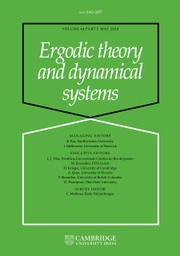Article contents
Furstenberg systems of pretentious and MRT multiplicative functions
Published online by Cambridge University Press: 03 February 2025
Abstract
We prove structural results for measure-preserving systems, called Furstenberg systems, naturally associated with bounded multiplicative functions. We show that for all pretentious multiplicative functions, these systems always have rational discrete spectrum and, as a consequence, zero entropy. We obtain several other refined structural and spectral results, one consequence of which is that the Archimedean characters are the only pretentious multiplicative functions that have Furstenberg systems with trivial rational spectrum, another is that a pretentious multiplicative function has ergodic Furstenberg systems if and only if it pretends to be a Dirichlet character, and a last one is that for any fixed pretentious multiplicative function, all its Furstenberg systems are isomorphic. We also study structural properties of Furstenberg systems of a class of multiplicative functions, introduced by Matomäki, Radziwiłł, and Tao, which lie in the intermediate zone between pretentiousness and strong aperiodicity. In a work of the last two authors and Gomilko, several examples of this class with exotic ergodic behavior were identified, and here we complement this study and discover some new unexpected phenomena. Lastly, we prove that Furstenberg systems of general bounded multiplicative functions have divisible spectrum. When these systems are obtained using logarithmic averages, we show that a trivial rational spectrum implies a strong dilation invariance property, called strong stationarity, but, quite surprisingly, this property fails when the systems are obtained using Cesàro averages.
MSC classification
Information
- Type
- Original Article
- Information
- Copyright
- © The Author(s), 2025. Published by Cambridge University Press
References
- 1
- Cited by


